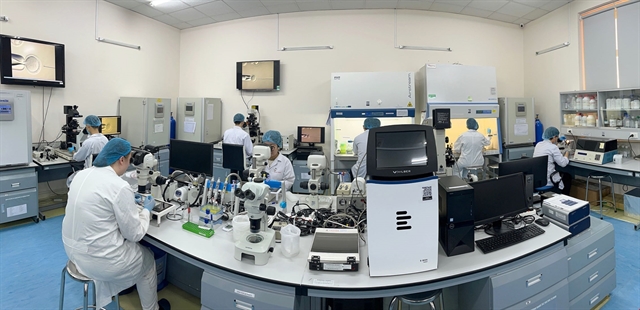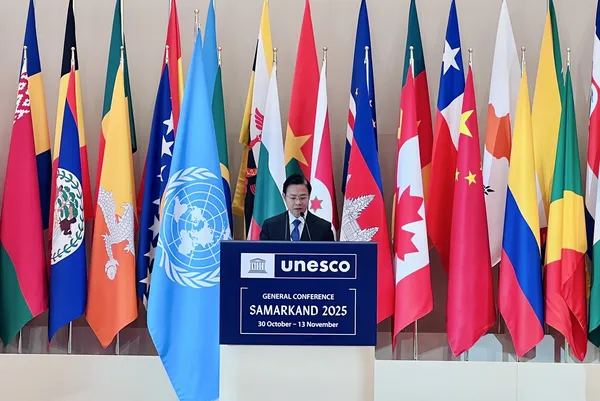 Society
Society

 |
| Scientific researchers work at the Biotechnology Laboratory, International University under the Việt Nam National University, HCM City. — VNA/VNS Photo Thanh Vũ |
HÀ NỘI — The Ministry of Science and Technology is urgently completing five new draft laws to create a legal framework to promote science and technology, innovation and digital transformation with hopes of having the laws passed in the coming months.
The laws being worked on are the Law on Digital Transformation, the amended High-Tech Law, the amended Law on Intellectual Property, the amended Law on Technology Transfer, and the Artificial Intelligence Law.
Deputy minister Lê Xuân Định said: "The amendments to these laws aim not only to update practice but also clearly show the determination to remove institutional bottlenecks, which have long been seen as major barriers to the development of science and technology, innovation and digital transformation."
The draft Law on Digital Transformation defines digital environment management and administration as the default, with paper-based management as an exception.
The state is responsible for ensuring that all citizens - regardless of age, gender, education level, geographical or economic conditions - have the opportunity to access and use online public services.
These systems must comply with international standards, have user-friendly interfaces, multilingual support, offer sign language and assistive forms for people with disabilities.
The platform must be compatible with many devices and have tools to support residents in remote and especially difficult areas.
The draft also requires designing online public services according to people's life events and business lifecycle, aiming for personalisation appropriate to individuals and organisations.
State agencies must coordinate to provide services in event chains rather than fragmented by administrative authority. Citizens and enterprises only need to provide information once, with seamless, uninterrupted processing that saves time and costs.
The proposed amendments to the High-Tech Law aim to promote technological autonomy, form strategic industries, increase the efficiency of high-tech zones, and encourage Make in Việt Nam enterprises.
The draft defines technology not only as a field of investment incentives but also as a strategic pillar ensuring economic security, national defence, and sovereignty.
The law adds concepts of strategic technology and strategic industry for focused development. Incentive policies are redesigned for transparency and effectiveness, expanded to domestic enterprises and start-ups. Core technologies, strategic technologies like artificial intelligence (AI) and semiconductors receive special incentives with commitments to technology transfer for national benefit.
The amended Intellectual Property Law contains changes aiming to transform Vietnamese research outcomes and inventions into assets that can be bought, sold and traded, moving towards an economy where intellectual property (IP) comprises a significant portion, as in developed countries.
The draft allows intellectual property rights to be valued, traded and used as assets, marking a shift from mere protection to creating assets, commercialisation and marketisation of research results.
Intellectual property becomes a strategic competitive tool for enterprises and the nation.
The draft prioritises purchasing IP rights related to important national security, socio-economic products, developing an IP ecosystem and encouraging investment in start-ups. Owners can determine value and asset lists for management if values are not yet recorded in accounting.
The draft of the amended Technology Transfer Law aims to complete the legal framework and promote effective, synchronous and internationally aligned technology transfer activities.
The new Technology Transfer Law draft simplifies administrative procedures, updates the list of new and strategic technologies and widens incentives for transfer activities.
It adds provisions on intermediary organisations for technology transfer, a common model abroad but lacking in Việt Nam, helping small enterprises and disadvantaged localities access and master new technologies.
The draft also strengthens cross-border transfer control to ensure technology security and foster Vietnamese technology export.
AI is developing faster than the pace of institutional building, creating a legal gap, especially in determining liability when AI causes damage. This issue is expected to be addressed by new regulations in the draft Artificial Intelligence Law.
The draft promotes AI pillars - Việt Nam AI infrastructure including national computing and data infrastructure, core platform models and technologies, human resources and intellectual community, application and innovation ecosystems, regulation, standards and AI safety. — VNS




